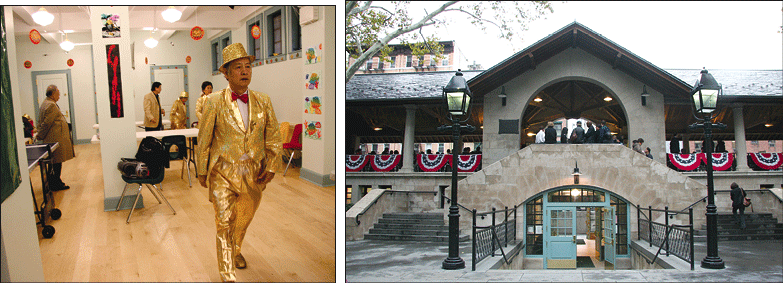By Julie Shapiro
When Parks Commissioner Adrian Benepe took the mic at the opening of the Columbus Park Pavilion, he said he didn’t want to keep the audience waiting any longer.
“We’ve already waited 100 years for this ceremony to start,” he said.
In fact, 110 years have passed since the pavilion was built at the north end of Columbus Park, and the structure had long been due for a renovation. Fenced off and deteriorating, the pavilion spent much of the last 30 years as a way station for homeless people and the city’s most ubiquitous bird.
“This was a pigeon pavilion,” Councilmember Alan Gerson said at the ceremony. “Now it’s a people’s pavilion.”
The pigeons are mostly gone — and they’ll stay that way if the netting and the “Do Not Feed The Pigeons” signs do their work — leaving Chinatown residents free to pack the pavilion for the ribbon-cutting ceremony on Thursday morning, Oct. 25.
The open-air pavilion, surrounded by landscaped plants, is accessible by restored stairs and a new elevator. The pavilion’s original wood ceiling beams, stripped of paint, support a newly extended roof.
The enclosed bottom floor of the pavilion contains a small recreational room, complete with a Ping-Pong table, along with a coatroom and public bathrooms. Currently decorated with pumpkin cutouts and wispy spider webs for Halloween, the space opened Oct. 1 to host art therapy and yoga classes, “Mommy & Me” programs and after-school and senior activities.
“It’s beautiful,” said Arthur Magnani, 80, who grew up in the neighborhood and still lives there.
When his parents came to New York in 1921, they went to dances in the pavilion. Magnani later spent summers swimming in a pool on the other side of the park. Back then, the neighborhood was Italian, but now the park, at Baxter and Bayard Sts., is part of Chinatown.
The local flavor permeated the ceremony, as performers clad in bright, sparkling costumes sang, danced and drummed up a storm, brightening the cool, gray day. When a line of officials with gold scissors snipped the green ribbon, cymbals clashed and a fabric lion — maneuvered by two members of Master Yip’s Martial Arts School — burst into dance.
“[The pavilion] is a great way to bring the community together for performances,” said William Castro, Manhattan Borough Commissioner.
His favorite part of the project is the landscaping, which includes new plants, benches and lighting.
“It’s fabulous,” said Jodi White, program manager at the Chinatown Partnership, a local development corporation. “This is great for the community.”
The park is usually packed and White hopes that everyone from community groups to teenagers will take advantage of the pavilion.
Justin Tan, 10, was among the students from the nearby Church of the Transfiguration school who attended the ceremony.
“It’s cool,” he said of the pavilion. “It’ll be a good opportunity for us.”
The pavilion is near the historic Five Points intersection, marking one of New York’s most well-known 19th-century neighborhoods. The movie “Gangs of New York” made the area famous.
The $4.1-million pavilion renovation required a variety of organizations to chip in. Gerson, a longtime advocate of the project, designated $720,000 out of his discretionary city funds. The Lower Manhattan Development Corporation provided $1.5 million and the federal government gave $1 million. Rounding out the funding, Mayor Michael Bloomberg gave $641,000 and former Borough President C. Virginia Fields gave $250,000.
The pavilion marks the final stage of Columbus Park’s renovations, which started with the playground on the south side and also included basketball courts and artificial turf playing fields.
Looking back on the project, Paul Gong, founder and president of Friends of Columbus Park, has mixed feelings.
“It’s a great day for the neighborhood to finally have the pavilion opened,” he said. “They did a nice job.”
However, Gong wanted the community to have more input. In particular, he wanted the open-air pavilion to be enclosed so it can be used year-round.
And while the public bathrooms are convenient, Gong worries that the Parks Dept. won’t put money into maintaining them.
“Our fear is that in five years it will look like crap again,” he said.
Now, Gong said, it’s up to the community to remain active and keep advocating for the pavilion.
“If you constantly have activity at the pavilion, it will be supported,” he said. “People will have a stake in it, chip in, keep it clean and get funding for it.”
Julie@DowntownExpress.com



























